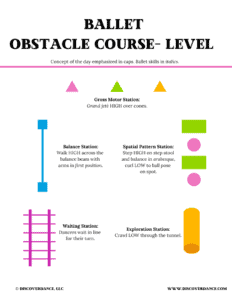Preschool Classroom Success: Obstacle Courses

When I created my classroom management plan, I first identified where my class became distracted and off-track. Then, I put a strategy in place to avoid the off-track behavior so it didn’t become an issue in the first place.
One section of my class where my students would always become distracted was across the floor time. Waiting for each of their dancemates to take a turn brought on a lot of chatter, wiggles, and potty break requests. My attention was often pulled from the dancer going across the floor to the dancers, impatiently, waiting their turn. I knew there had to be a better way to develop skills with less sitting and waiting. That’s when I created the five-station obstacle course.
Not only do obstacle courses allow us to develop more skills in one class, but by strategically planning what each station will be, I am able to incorporate three sets of skill development: foundational, codified, and conceptual. Foundational skills are the skills our students need first in order to learn and move. Codified skills are what our students need to progress in the style of dance they are learning. Conceptual skills are the skills our students need in order to understand and apply all the amazing ways their bodies can move. These skills help them develop their codified skills more effectively.
We begin with the framework. No matter what age, stage of development, or style of dance we are teaching, the framework remains the same.
The first station is the Waiting Station. We wait along our train track (taped to the floor or a yoga mat) or poly spots until it is our turn to begin the obstacle course. Even though we are waiting in line, we have an important job that helps keep us engaged. When the track/spot in front of us is empty, we move up a space. By training our youngest dancers on how to move in a line, we are setting the foundation for across the floor work later in their dance education. They are learning to pay attention and to keep the line moving.
Next is the Balance Station. Any skill development that challenges balance will go here. This includes vestibular and proprioceptive activities along with static and dynamic balance activities. This could be a balance beam, stepping stones, walking up and down a wedge mat, log rolls across a mat, balancing a bean bag on a body part, or spinning then freezing without wiggling wobbly, or falling down.
After balancing we move into the Gross Motor Station. This station will include large motor movements such as jumps, hops, gallops, leaps, and skips. Anything that moves our large muscle groups will go here.
Next is the Spatial Pattern Station. In this station we will set up different spatial patterns for the dancers. This could be with agility hoops of all sizes, poly spots, poly feet, domes, etc. We want to create different pathways and patterns for the dancers to perform.
The last station is the Exploration Station, this is where we allow the dancers another opportunity to explore the concept of the day on their own.
Now that we have our framework, let’s add our codified skill development. For this example, let’s create a ballet obstacle course.
Waiting Station: Remains the same every week.
Balance Station: Walk across the balance beam with arms in first position.
Gross Motor Station: Grand jeté over cones.
Spatial Patterns: Balance in arabesque on a step stool. Curl to ball pose on a poly spot. Repeat.
Exploration Station: Crawl through the tunnel.
Lastly, it’s time to thread in our concept of the day. Read more about conceptual teaching here. For this example, let’s create a ballet obstacle course exploring the concept of LEVEL.
Waiting Station: Remains the same every week.
Balance Station: Walk HIGH across the balance beam with arms in first position.
Gross Motor Station: Grand jeté HIGH over cones.
Spatial Patterns: Balance HIGH in arabesque on a step stool. Curl LOW to ball pose on a poly spot. Repeat both.
Exploration Station: Crawl LOW through a tunnel.
From one activity, we have accomplished so much! And, bonus, our dancers stayed engaged and excited through each station. It’s amazing how a simple tool like an obstacle course can not only help classroom flow, but assist in such a large part of skill development in our early childhood dance classes. Give it a try and let me know how it goes!
Andrea Trench is dedicated to helping dance teachers create and deliver content that is research-based and developmentally appropriate for children under the age of 6. Her primary focus is classroom management, conceptual teaching, and foundational movement skill development in early childhood dance education. In addition, Andrea uses her 12 years of experience as a partner in a dance studio to inspire, equip, and empower educators.









